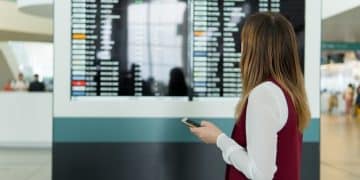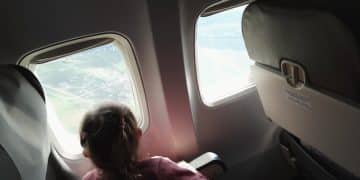New FAA Drone Regulations Near Airports: Travel Impact
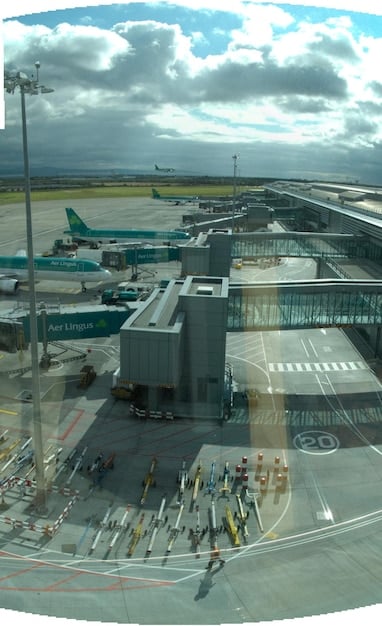
The Federal Aviation Administration (FAA) has implemented new regulations governing drone operations near airports, primarily aimed at enhancing aviation safety for commercial and recreational travelers by restricting drone flights in controlled airspace without explicit authorization.
The landscape of air travel and personal technology is ever-evolving, and with the proliferation of unmanned aerial vehicles, known as drones, new considerations for safety and regulation become paramount. Recent changes in the Federal Aviation Administration (FAA) guidelines regarding drone use near airports have significant implications for air travelers and drone enthusiasts alike. Understanding these New FAA Regulations for Drone Use Near Airports: What Travelers Need to Know is crucial for ensuring sky safety and avoiding legal complications, shaping how we navigate the airspace, both human-piloted and remotely operated.
Understanding the Core Changes in FAA Drone Regulations
The FAA’s updated regulations concerning drone operations near airports represent a significant shift in managing shared airspace. These changes are designed to enhance safety, primarily by minimizing the risk of collisions between drones and manned aircraft, especially during critical phases of flight like takeoff and landing. Travelers and drone operators must recognize that the sky is not limitless, and even small unmanned aircraft can pose substantial threats if not properly managed.
Previously, many individuals operated drones without a deep understanding of the airspace classifications or the potential hazards. The new rules aim to close these gaps by establishing clearer boundaries and mandatory authorization processes. This is not just about preventing accidents; it’s about fostering a culture of responsible drone use that coexists harmoniously with traditional aviation.
Enhanced Airspace Authorizations
central to the new regulations is the requirement for explicit authorization to operate drones within controlled airspace – particularly near airports. This moves beyond a simple “no-fly zone” to a tiered system that, while restrictive, also offers pathways for authorized operations under specific conditions.
- LAANC (Low Altitude Authorization and Notification Capability): This system provides near real-time authorization for drone operations in controlled airspace, usually in proximity to airports. It’s a critical tool for recreational users and commercial operators alike, simplifying what was once a complex waiver process.
- Manual Authorizations: For more complex operations, or in areas not covered by LAANC, manual authorization through the FAA DroneZone portal is still required. This involves a more detailed application process and longer review times.
These authorization systems are not mere bureaucratic hurdles; they are safety mechanisms. They allow air traffic control and airport management to be aware of drone activity, helping to prevent conflicts and ensure the safety of all aircraft. Travelers, while not directly operating these systems, benefit immensely from the increased situational awareness these authorizations provide.
The regulations also emphasize geographical zones and altitude limits. Strict limitations are imposed on how high a drone can fly, especially near an airport, and exclusion zones are clearly delineated. These measures are direct responses to incidents where drones have interfered with aircraft, sometimes leading to rerouted flights or even temporary airport closures. By creating clear, enforceable boundaries, the FAA seeks to maintain the efficiency and safety of air travel.
Why These Regulations Matter to Air Travelers
While drone operations might seem disconnected from a passenger’s typical airport experience, the new FAA regulations have direct and indirect impacts on air travel. Travelers often overlook the intricate dance of aircraft in the skies surrounding an airport, but any disruption can have cascading effects, from minor delays to serious safety concerns.
The primary benefit for travelers is enhanced safety. Drones, even small ones, can cause significant damage to aircraft engines or structural components if a collision occurs. Such incidents could lead to emergency landings, extensive repairs, and, in the worst-case scenario, catastrophic events. By regulating drone flight paths and requiring authorizations, the FAA significantly reduces the likelihood of such dangerous encounters, ensuring that your flight is as secure as possible.
Minimizing Flight Delays and Disruptions
Incidents involving unauthorized drones near airports have historically caused widespread disruptions. A confirmed drone sighting can lead to immediate grounding of flights, rerouting of incoming aircraft, and temporary closures of runways. These measures, while necessary for safety, result in significant delays, missed connections, and general inconvenience for thousands of passengers.
- Fewer Ground Stops: Stricter regulations mean fewer instances of unauthorized drones entering airport airspace, which translates to fewer ground stops and fewer hours spent waiting on the tarmac or in airport terminals.
- Predictable Schedules: With reduced drone-related incidents, airlines can maintain more predictable schedules, improving overall operational efficiency and passenger satisfaction.
Economic impacts also play a role. Flight delays and cancellations due to drone incursions cost airlines and travelers millions of dollars annually. When flights are regularly disrupted, it affects everything from baggage handling to international connections. The new regulations, by imposing penalties and making unauthorized drone operation more difficult, deter reckless behavior, safeguarding the integrity of the air travel system and, by extension, the traveler’s itinerary.
Ultimately, these regulations contribute to a smoother and more reliable travel experience. Knowing that stringent measures are in place to manage the airspace around airports allows travelers to have greater peace of mind. It reinforces the idea that every aspect of flight safety, from the largest airliner to the smallest drone, is under constant, careful scrutiny by regulatory bodies.
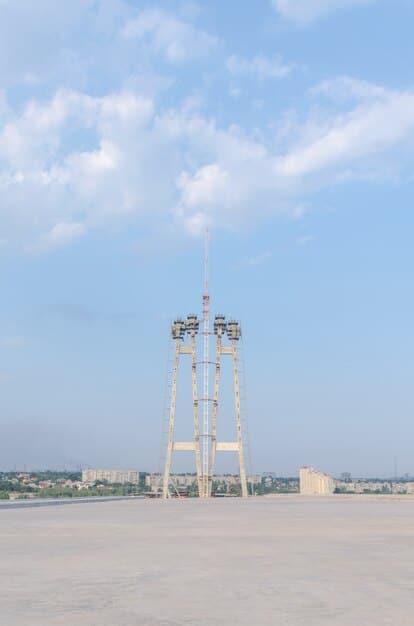
Key Prohibitions and No-Fly Zones for Drone Pilots
For drone pilots, understanding the explicit prohibitions and defined no-fly zones is not merely a recommendation; it’s a legal imperative. Ignorance of these rules is not a defense, and violations can lead to severe penalties, including hefty fines and even imprisonment. The FAA’s stance is clear: safety in the national airspace is paramount, and drone operators share a significant responsibility in maintaining it.
The most critical prohibition involves operating a drone within five miles of an airport without prior authorization. This “five-mile rule,” while often cited, is now more nuanced due to systems like LAANC, which allow for flight in some of these zones under specific conditions. However, the fundamental principle remains: if you are near an airport, assume restrictions apply and seek authorization.
Permanent Flight Restrictions
Certain areas are designated as permanent no-fly zones for drones, regardless of proximity to an airport. While these zones are not directly tied to airport operations, they reinforce the broader regulatory framework that drone pilots must adhere to.
- National Parks: Drone flights are generally prohibited in National Parks, a rule designed to protect wildlife and ensure visitor privacy and safety.
- Military Facilities and Critical Infrastructure: Operating drones near sensitive government installations, power plants, correctional facilities, or other critical infrastructure is strictly forbidden due to security concerns.
Beyond these, temporary flight restrictions (TFRs) are often issued for special events, such as major sporting events, public gatherings, or disaster relief efforts. These TFRs can significantly impact drone operations and are crucial for pilots to check before every flight. For travelers, awareness of these zones means understanding why certain security measures might be visible or why flight paths might be altered during specific events.
The FAA also explicitly prohibits operating drones under the influence of alcohol or drugs, flying recklessly, or operating in a manner that endangers the safety of the national airspace system. These regulations are designed to prevent foreseeable risks and ensure that drone pilots act responsibly, much like pilots of manned aircraft are held to strict standards. Penalties for non-compliance are not trivial; they underscore the seriousness with which the FAA views drone safety. By enforcing these prohibitions, the FAA creates a safer environment for everyone, including those within the confines of an airport.
How Travelers Can Report Suspicious Drone Activity
While drone regulations are primarily aimed at operators, travelers also play a role in ensuring airspace safety. Observing suspicious or unauthorized drone activity, especially near airports, is something every traveler should know how to report. Your vigilance can be a crucial factor in preventing potential hazards and ensuring the smooth operation of air traffic.
The key is to understand what constitutes “suspicious” activity and how to relay that information effectively to the appropriate authorities. Not every drone you see is a threat or operating illegally; many are flying in compliance with regulations. However, if a drone appears to be flying too close to an airport, over restricted areas, or behaving erratically, it warrants attention.
Steps for Reporting
If you observe a drone that you believe is operating illegally or poses a risk, there are specific steps you should take to report it. Providing clear, concise, and accurate information is vital for authorities to act swiftly and appropriately.
- Do Not Intervene Directly: Never attempt to confront a drone operator or interfere with a drone yourself. This could be dangerous and counterproductive.
- Note Key Details: Observe everything you can about the drone: its size, color, approximate altitude, direction of travel, and how close it is to an airport or aircraft. If you can, note the operator’s description or vehicle information if they are visible.
- Contact Airport Authorities or Local Law Enforcement: The most immediate and effective way to report is to notify airport personnel (e.g., ground staff, airport police) or your local law enforcement agency. Many airports have direct lines or procedures for reporting such incidents.
For less immediate reports or if you are outside the immediate airport vicinity, the FAA has channels for reporting unauthorized drone activity. This often involves contacting the appropriate FAA Flight Standards District Office (FSDO) or using their online reporting tools. While these methods are important, immediate threats require immediate contact with local authorities.
It’s important to remember that false reports can tie up valuable resources, so ensure your observation is genuinely concerning before reporting. However, if you genuinely believe there’s a risk, err on the side of caution. Your proactive actions, coupled with the FAA’s comprehensive regulations, create a robust safety net for the entire aviation community, from pilots and air traffic controllers to the everyday traveler.
Future Implications for Drone Technology and Travel
The current FAA regulations are not static; they represent a dynamic response to a rapidly evolving technological landscape. As drone technology continues to advance, becoming more sophisticated and integrated into various industries, future implications for both drone use and air travel are profound. The ongoing dialogue between innovation and regulation will shape how we interact with airspace in the years to come.
One significant area of development is the concept of Urban Air Mobility (UAM), which envisions a future where autonomous passenger and cargo drones operate within urban environments. This will necessitate even more refined and extensive regulatory frameworks to ensure safety, efficiency, and public acceptance. For travelers, UAM could mean new forms of inter-city transport, vastly changing the dynamics of short-haul journeys and airport connectivity.
Technological Advancements and Regulatory Evolution
The pace of technological innovation often outstrips the speed of regulatory bodies. However, the FAA is actively working to bridge this gap, exploring solutions that could enhance drone integration without compromising safety.
- Remote Identification (Remote ID): This technology, now mandated for most drones, acts like a “digital license plate” for drones, allowing authorities to identify drones operating in the airspace. This enhances accountability and helps to deter illegal operations.
- Geofencing Technology: Many modern drones come equipped with built-in geofencing, which automatically prevents them from flying into restricted airspace. As this technology becomes more refined and ubiquitous, it will serve as an increasingly effective preventative measure.
Beyond these immediate advancements, the long-term future includes concepts like unmanned traffic management (UTM) systems, which would effectively act as an air traffic control system for drones. This would allow for seamless, safe integration of a much higher volume of drone traffic into the national airspace, potentially unlocking new services like drone deliveries and aerial inspection services on a massive scale.
For travelers, these developments hold the promise of increased convenience and efficiency, but also new considerations for personal privacy and security. As drones become more commonplace, the definition of “air travel” itself may expand beyond traditional aircraft. Staying informed about these evolving regulations and technological breakthroughs will be key to navigating the skies of tomorrow. The FAA’s approach is one of continuous adaptation, ensuring that the skies remain safe while embracing the potential of new aerial technologies.
Navigating Airport Environments as a Drone Owner
For individuals who own drones and plan to travel, understanding how to navigate airport environments, both as a passenger and as a drone enthusiast, is essential. This often involves more than just knowing where you can and cannot fly; it also includes considerations for transporting your drone, understanding airport security procedures, and being aware of local regulations at your destination.
When packing a drone for air travel, remember that battery regulations are strict. Lithium-ion batteries, common in drones, must typically be carried in your carry-on luggage, not checked, to mitigate fire risks. It’s also advisable to discharge them to a certain level before travel. This small detail, often overlooked, can lead to significant delays and complications at security checkpoints.
Airport Security and Drone Transportation
TSA officials are increasingly familiar with drones, but presenting your drone clearly and separately from other electronics can expedite the screening process. Be prepared for additional checks, as the components of a drone can sometimes trigger alarms in X-ray machines.
- Battery Management: Carry spare batteries in fireproof bags or with protective caps on terminals to prevent short circuits.
- Drone Disassembly: If possible, disassemble your drone for transport, protecting delicate components like propellers and sensors.
Beyond security, consider the regulations at your destination. Just because you can fly a drone legally in one location does not mean the same rules apply elsewhere. Countries, states, and even local municipalities often have their own specific drone laws that might be more restrictive than federal FAA regulations. This due diligence is crucial to avoid inadvertently breaking local laws and facing penalties.
Furthermore, be mindful of the “traveler’s perspective” when considering launching your drone. Flying a drone near hotels, tourist attractions, or populated areas can raise privacy concerns among others. While not directly an FAA regulation concerning airports, a responsible drone operator considers the impact of their flight on those around them. Adhering to both the letter and the spirit of the law, including being a considerate pilot, ensures a better experience for everyone and reinforces the positive image of the drone community.
Potential Penalties for Non-Compliance
Disregarding the new FAA regulations for drone use near airports carries significant legal ramifications. These are not mere suggestions; they are federal laws designed to protect public safety and the integrity of the national airspace. Ignorance of the law is not an excuse, and authorities are increasingly equipped and willing to enforce these regulations with severe penalties.
The exact penalty depends on the nature and severity of the violation, ranging from civil penalties (fines) to criminal charges, potentially involving imprisonment. The FAA takes unauthorized drone operations near airports particularly seriously, given the direct threat they pose to manned aviation and the thousands of lives onboard commercial aircraft.
Examples of Penalties
Even seemingly minor infractions can lead to substantial fines, underscoring the FAA’s commitment to strict enforcement. Repeated offenses, or those that cause direct harm or disruption, can escalate quickly.
- Civil Penalties: Fines for recreational drone operators can be substantial, sometimes reaching tens of thousands of dollars for a single unauthorized flight in restricted airspace. For commercial operators, these fines can be even higher.
- Criminal Charges: In cases where a drone operation knowingly endangers aircraft or individuals, or if it involves intent to cause harm, criminal charges can be filed. This can lead to federal prison sentences and a permanent criminal record.
Beyond these direct legal consequences, unauthorized drone use can also result in the confiscation of the drone and any related equipment. Furthermore, incidents can lead to intense public scrutiny and negative media attention, particularly if they cause widespread travel disruptions or near-misses with aircraft.
It’s also worth noting that other federal agencies, such as the Department of Homeland Security and the FBI, may become involved in cases of significant security breaches or threats. This multi-agency approach highlights the seriousness with which drone-related incidents are viewed at a national level. For Travelers, this means the regulatory framework provides a formidable deterrent against reckless drone operations, ultimately contributing to a safer and more secure air travel experience.
| Key Point | Brief Description |
|---|---|
| ✈️ Airspace Safety | New rules enhance safety by restricting drone flights near airports, minimizing collision risks with aircraft. |
| ✅ Authorization Required | Most drone operations in controlled airspace require explicit FAA authorization via LAANC or manual processes. |
| 🚨 Reporting Suspicious Activity | Travelers should report unauthorized drone sightings to airport authorities or local law enforcement. |
| ⚖️ Penalties for Non-Compliance | Violations can lead to significant civil fines and, in severe cases, criminal charges or imprisonment. |
Frequently Asked Questions About FAA Drone Regulations for Travelers
▼
The new FAA regulations primarily aim to enhance aviation safety by preventing collisions between drones and manned aircraft, particularly in the critical airspace around airports. They also seek to standardize rules for recreational and commercial drone operators, reducing flight disruptions and ensuring a more predictable air travel system for passengers.
▼
These regulations directly impact travelers by contributing to fewer flight delays and cancellations caused by unauthorized drone activity. They foster a safer airspace, which means less risk of mid-air incidents and smoother airport operations, ultimately leading to a more reliable and comfortable travel experience for all passengers flying in and out of airports.
▼
Yes, in many cases, you can fly your drone near an airport, but explicit authorization from the FAA is almost always required. Systems like LAANC offer near real-time approval for recreational and commercial operations in controlled airspace, helping qualified operators adhere to regulations safely and legally, avoiding unauthorized flights.
▼
If you observe a drone operating unsafely or in a suspicious manner near an airport, you should immediately report it to airport authorities or local law enforcement. Do not attempt to intervene yourself. Provide as many details as possible, such as the drone’s appearance, location, and behavior, to assist authorities in their response.
▼
Absolutely. The FAA imposes strict penalties for non-compliance, which can range from significant civil fines, potentially costing thousands of dollars, to severe criminal charges, including imprisonment, depending on the severity of the violation. These penalties underscore the critical importance of adhering to all drone regulations for public and air travel safety.
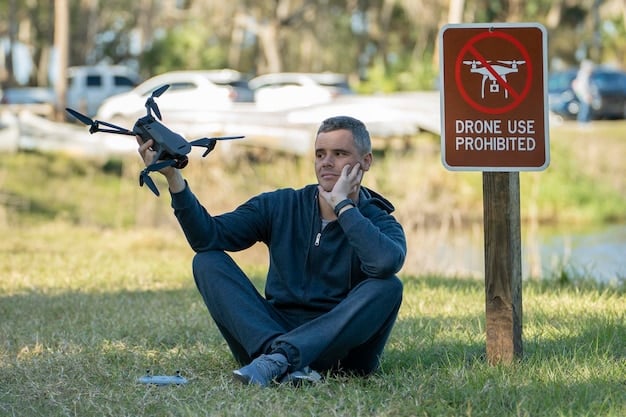
Conclusion: Ensuring a Safer Sky for Everyone
The new FAA regulations concerning drone use near airports reflect a crucial step in adapting to the realities of a shared and increasingly complex airspace. For travelers, these rules translate directly into enhanced safety, fewer disruptions, and a more reliable air travel experience. While drone pilots must now navigate a more formalized process of authorization and adherence to no-fly zones, these measures are ultimately designed for the collective good, mitigating risks that could have severe consequences. The ongoing evolution of technology and regulation ensures that our skies remain secure and efficient for all users, fostering confidence in every journey.

